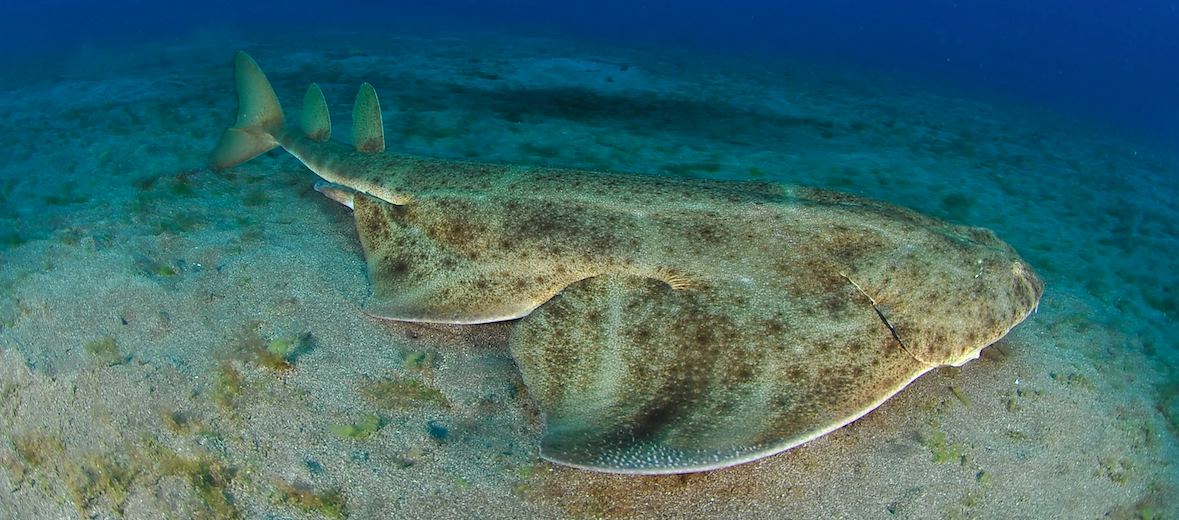
There are approximately 22 known species of angel shark, found worldwide in temperate and tropical seas. These sharks inhabit sandy seabeds, at depths of up to 490 feet. These odd-looking critters have flattened bodies and broad pectoral fins. Their initial appearance is that of a ray. The dermal denticles (tiny scales that form their skin) of these sharks gives them a rough, sand paper feel. Due to overfishing, habitat destruction, and human interference – in the form of recreational activities, these sharks are listed as Critically Endangered by the IUCN. Their populations are also decreasing.
First the Stats…
Scientific name: Squatina squatina
Weight: Up to 77 lbs.
Length: Up to 6.5 feet
Lifespan: Up to 35 years
Now on to the Facts!
1.) Like all other bottom dwelling sharks, angel sharks have barbels on the underside of their snout that are used, in part, to locate food.
2.) These sharks have 2 pairs of 5 gills, located on the underside of their body.
3.) They prey on fish, crustaceans, mollusks, and squids.
4.) Being ambush predators, they will lay motionless in the sand and await passing prey to happen by. Then they engulf their prey within 1/10th of a second!
5.) They don’t breathe via obligate ram ventilation. This is where they have to swim in order to get oxygenated water over their gills. These sharks don’t pump out water from the oropharyngeal cavity like other fish. Rather, they use gill flaps located under their body to pump out water during respiration.
But wait, there’s more on the angel shark!
6.) Some angel sharks have been found with deformities called elasmobranchs. These include: humpback curvatures (khyphosis); skeletal deformities, like lateral spinal curvatures (scoliosis); missing fins; extra fins; axial spinal curvature (lordosis); deformed snouts; and more. It is presumed that these deformities are the result of poor diet, injuries, genetics, possible parasitic infections, and more.
7.) They are ovoviviparous (producing young via eggs which are hatched within the body of the female), then the young sharks are born live.
Did you know…?
Human attacks are rare and only happen when the shark is provoked or threatened. But bites are painful, due to their long, needle-like teeth.
8.) Females undergo up to a 10 month gestation (pregnancy) that yields up to 13 pups.
9.) During the day, they remain buried in the sandy bottom and can wait there, sometimes, for weeks for passing prey. At night, they can actively hunt by cruising along the ocean bottom looking for prey.
10.) By 1985, the annual take of angel sharks along the central California coast had increased to more than an estimated 90,000 sharks per year! Obviously, their populations were reduced significantly. They are now, as a result, regulated.
But wait, there’s still more on the angel shark!
11.) Due to the fact that angel sharks live so close to the shore, they are at risk of significant bycatch (unwanted fish and other marine creatures caught during commercial fishing) rates and thus are at continued risk of extinction.
12.) In April 2008, the UK government awarded the angel shark full protection under the Wildlife and Countryside Act, in an effort to preserve these incredible creatures.
13.) Only 30% of angel shark pups reach adulthood. This is due, in part, to predation by larger fish and sharks.
14.) Great white sharks, broadnose seven-gill sharks, and northern elephant seals all prey on these sharks.
Now a Short Angel Shark Video!
Be sure to share & comment below! Also, check out the Critter Science YouTube channel. Videos added frequently!
Want to suggest a critter for me to write about? Let me know here.



